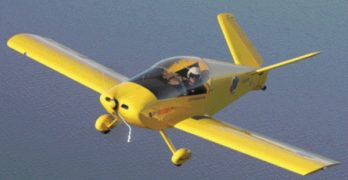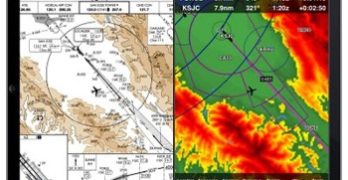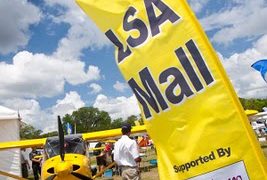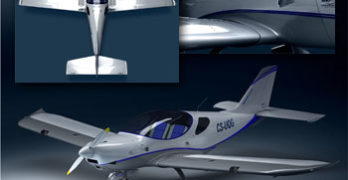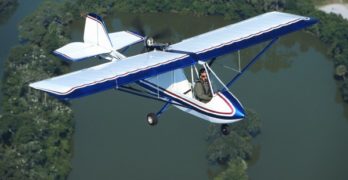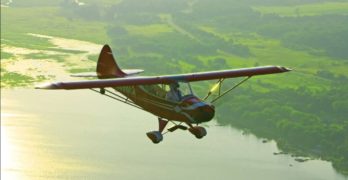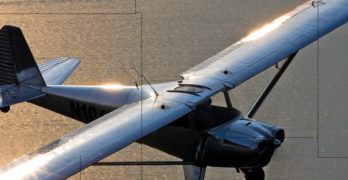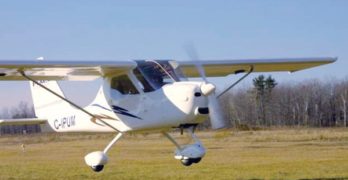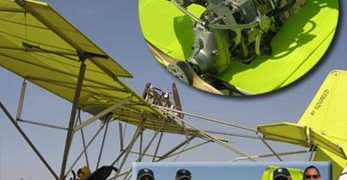Pedal to the Metal
The Y-Tail Waiex combines unusual style with refreshing speed.
The airlines may be suffering and
Light-Sport Aircraft (LSA) has yet to
coalesce into a coherent industry
segment, but Sonex Ltd. is having a fine run
of business. During my visit on a beautiful
fall day in Oshkosh, Sonex said it was ready
to break ground on a new hangar, the third
building of what has become the Sonex
campus on Wittman Field. At press time, it
was nearly complete.
Sonex is clearly ready for LSA, but
the company has built its enterprise on
delivering kits to the Experimental/ Amateur-
Built community. Steadily selling kits
keeps Sonex in good business shape while
LSA comes into focus. This company is well
positioned for whatever future recreational
flying holds.
$22,260. That calculates to an amazing $148
per mph.
Most of us don’t think in terms of
dollars per mph-and the comparison
with the RV-9 ignores the fact that
the RV is larger, heavier and, as a result,
more cross-country capable-but it
certainly proves that the Monnett machine
won’t take too much of your money for the
speed it can deliver.
Search Results for : Revo
Not finding exactly what you expected? Try our advanced search option.
Select a manufacturer to go straight to all our content about that manufacturer.
Select an aircraft model to go straight to all our content about that model.
GPS Alien vs. Predator
Yesterday in our Ultraflight Radio interview Jim Sweeney and I compared and contrasted two red-hot digital instruments for the cockpit: the Adventure Pilot iFly 700 and the Apple iPad with its tons of aviation apps; see my earlier post on the Zlin iCub. *** To learn more about these two amazing digital toys I also swapped emails with Walter Boyd of Adventure Pilot, who created and does all the incredible programming for the iFly 700. *** Full Disclosure: I just bought an iFly 700 yesterday — couldn’t deny myself any longer! *** First, the iPad, (projected to sell at least 6 million units by year’s end — over 3 mil already!), offers much more than a GPS moving map. As Walter acknowledges, it’s a portable computer optimized for viewing rather than producing information, as on a laptop or netbook. *** Next, it’s big: a 9.7 inch diagonal, beautiful bright screen.
FAA To Change ASTM Certification?
News began filtering out today that FAA informed LAMA (Light Aircraft Manufacturers Assoc.) that it is strongly considering imposing new mandates on how S-LSA designs are approved. *** LAMA chairdude Dan Johnson sent a strong message to LAMA members that FAA may require LSA makers to pass compliance audits managed by a team of FAA inspectors, rather than the manufacturer-certified voluntary nature of the certification program as it now exists, where airframe builders can pay for an audit through LAMA, but are not required to do so. *** Earl Lawrence of EAA talked in depth about this development on the Ultraflight radio program Tuesday July 13th; check their archives to hear the full interview. I appeared on the radio show later in the program to talk about the state of the industry and what’s coming with electric LSA. *** I also got more info from Dan on what this portends for the S-LSA industry as a whole.
Judging Winners Sun ‘n Fun 2010
I once followed judging at shows like AirVenture and Sun ‘n Fun. In fact, an aircraft I helped inspire — a modernized primary glider called the SuperFloater — won Outstanding New Design at Sun ‘n Fun 1995. Judges closely examined homebuilts, kit or restored vintage airplanes, and warbirds. If they included factory built aircraft, I was not aware of it. *** So, this year I admitted surprise after learning factory-built Light-Sport Aircraft won awards. *** To honor the hundreds or thousands of hours people put into their winners, I want to highlight some LSA and ultralights that judges liked. The Grand Champion LSA was Wayne Spring’s 2010 Predator powered parachute; Reserve Grand Champ was James Jonannes’ 2009 Arion Lightning LS-1; Grand Champion Ultralight was James Wiebe’s 2010 Belite Superlite; and, Reserve Grand Champ was Danny Dezauche’s 2010 CGS Hawk Ultra.
First Major Corporate Change in LSA World
A long and winding trail in the sky, this story is… Once upon a time an American traveled to the Czech Republic, founded a small business to build kit aircraft, grew that into a full-fledged LSA producer, gained an investor with whom he later disagreed, and lost his enterprise. That’s the shortest possible take on it. When Chip Erwin’s Czech Aircraft Works dissolved, the chrysalis produced Czech Sport Aircraft… the new owner of the SportCruiser (photos). As Chip takes an unplanned sabbatical from this business, the new team under Martin Zikes is taking action. *** Czech Sport Aircraft (CSA) says its roots date back to 1934 when “a group of aviation enthusiasts opened a small workshop and started to build gliders.” Around World War II a related factory was seized by the Luftwaffe and served as a repair and maintenance facility. “After the war the company worked on all types of airplanes then flying in Czechoslovakia.
Successful Low-Cost Light Planes
“I started the company in 1983, and I still own it,” reports Dave Goulet, the main man behind the Challenger aircraft design and Quad City Ultralight Aircraft Corporation. “In fact,” he adds, “it’s probably the oldest ultralight company still under the same management. “After reviewing all the ultralight companies I can think of, I’m inclined to agree.”
Thinking of other long-term operations, Goulet mentions The New Kolb Aircraft Company, whose roots are also planted deep, but even that storied company has now changed ownership… twice in the last decade, and most recently just a couple years ago.
Quicksilver Mfg. has been around longer, but the revolving door of managers and several changes of ownership have long since taken that familiar brand out of contention for continuous leadership.
About the only challenge to Challenger’s continuity reign that I can think of would be Chuck Slusarczyk, designer of the Hawk series, and his company, CGS Aviation.
Savage Cub-like Taildragger
As we near the fourth anniversary of the introduction
of the first special light-sport aircraft
(S-LSA) in April 2004, notable successes have
been achieved. With approximately 1,000 fixed-wing
LSA-plus several hundred flex wings-in the national
fleet, and with the entry of Cessna and Cirrus into the
LSA marketplace, LSA have clearly become part of the
aviation scene.
Whatever the soothsayers predict for the future
of LSA, one fact has been established: Pretty yellow
taildraggers generate a solid following. Combining
the sales of American Legend Aircraft’s Legend Cub,
CubCrafters’ Sport Cub, and European supplier Zlin’s
Savage, nearly one in five S-LSA registered in the FAA’s
database are yellow taildraggers.
American Legend currently leads in market share, but
CubCrafters steadily rose through the ranks during 2007.
Well down the list, but with mounting registrations, is the
Zlin Savage. Though it more closely resembles the RANS S-7
Courier than the traditional J-3 Cub, the Zlin taildragger has
much to offer.
New Old Planes — Luscombe & Champ
Luscombes and Champs
with a New Lease on Life
Pilots of the world, meet American know-how building American airframes powered by American powerplants. This month, we offer not one but two such airplanes, the Luscombe Silvaire LSA-8, and the American Champion Aircraft Champ.
These flying machines offer not only homeland availability but homeland pricing as well. Neither is subject to constant price increases from a soaring euro, and when Europe finalizes acceptance of ASTM
standards (see “Europe, EASA, and Light-Sport Aircraft” page 36), these planes may be a compelling purchase for Europeans. An LSA-8 or Champ might seem downright cheap in Europe (approximately 55,000 euros plus shipping). Globalization works in both directions!
Two-thirds of the approximately 1,270 airplanes in today’s current light-sport aircraft (LSA) fleet (as of April
2008) were built overseas, but recent entries by American companies joining the LSA parade could change those numbers. At times of rising LSA import prices and skyrocketing
fuel costs, these are two affordable aircraft Americans ought to consider.
Flying the Puma
One of Canada’s best-kept secrets can be found hidden
away in a northeastern Ontario town called Hawkesbury. That
secret is the PUMA – a little plane being imported into Canada by
Humberto Dramisino of Otreb Technologies.
When you look into the history of ultralight and light sport aviation,
it’s interesting to note that the successful manufacturers are the ones
that introduce a design and then adjust it as times goes by to better fit
the ever-changing aviation marketplace.
This is what has lead to the success of the PUMA. Designed in Italy
by Antonio Bortolanza, the aircraft has undergone a number of design
transitions since it was first introduced in ’85. Dramisino has been
involved with the manufacture of the PUMA from a very early age. He
first started working in the factory when he was only 15 years of age,
“working just for the pleasure of working on airplanes,” he says.
Rotary Power for M-Squared’s Part 103 Ultralight
In the late 1970s, Mazda popularized the rotary engine for their RX-7 sports car. Such engines are particularly known for their smooth running operation. Many aviators can appreciate low-vibration powerplants but especially those flying the lightest of recreational aircraft, namely Part 103 machines. *** Now, M-Squared has partnered to offer such a combination. Revolution Rotary Engines Inc., a Canadian-based manufacturing company located in Markham, Ontario connected with M-Squared‘s Paul Mather to exploit the possibilities of rotary power. At Sun ‘n Fun 2008, M-Squared showed a single place, strutted Breese with the R301A single cylinder rotary engine supplying 35 horsepower. Installed on M-Squared’s lightweight Breese SS (single seat), the aircraft is said to remain within 103’s tight parameters (assuming the buyer does not insist on options and accessories that would bump it over weight). *** The single rotor aircraft engine looks compact and weighs a reported 40 pounds.
- « Previous Page
- 1
- …
- 9
- 10
- 11
- 12
- 13
- …
- 15
- Next Page »


